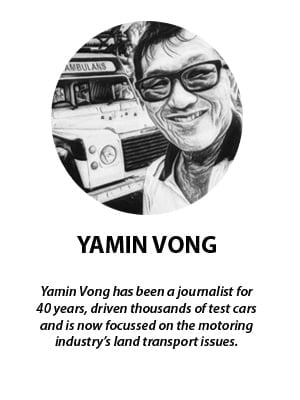
Advanced countries like the UK usually experience a decline in traffic crashes over the years. Malaysia, however, seems to defy the convention.
Police figures show there were a total of 6,433 deaths on the road last year, the highest number ever reported, while the 598,635 crashes registered broke a new record.
Did you happen to see a viral video of a JPJ driving test, where a girl had to touch and call out the names of the parts of a car such as the headlights and rear lights?
I thought it was a fake video but upon checking, it was confirmed to be genuine.
If this is the kind of driving test that has been mandated by the road transport department, then can it be any wonder why traffic fatalities are increasing?
The Malaysian Institute of Road Safety Research (Miros) has emphasised that human error is a significant contributing factor to traffic fatalities in Malaysia, as has the National Highway Traffic Safety Administration of the US.
The long-term solution is to enhance the driving test standards to ensure that drivers are adequately trained and tested on essential driving skills and knowledge.
JPJ had some years ago announced some plans about conducting driving tests in a virtual environment. Could the viral video of the girl doing her tragic-comic driving test be a travesty of that driving simulator testing previously talked about?
But which politician is willing to be unpopular and talk about making driving tests a real driving test, especially in these times where, seemingly, the tail wags the dog?
Speaking of populism, the government has made a logical decision to allocate its RM37 million toll subsidy to the two days before Hari Raya. This will stretch out the outbound traffic peak to three days, from Sunday until Tuesday midnight.
There are many other key factors that Malaysia’s citizens, civil service, corporate and other entities can tackle to reduce traffic fatalities.
Minimising the use of handphones while driving could immediately reduce the number of traffic crashes.
Distracted driving, speeding, impaired driving (such as driving under the influence of alcohol or drugs), aggressive driving, fatigue, and general failure to obey traffic laws are the immediate causes of road deaths.
We can make more efforts at inculcating a safety-first attitude. Some companies in the safety-first oil and gas industry specifically prohibit their employees from texting while driving.
Shell Malaysia was one of the first to implement this ban on its employees as part of its occupational safety and health guidelines.
Observing how there are express bus drivers who can be observed using their handphones while driving until today, I wonder if the land public transport agency (APAD) and express bus companies can work closer together and do more to protect passenger safety.
And how about e-hailing platforms like Grab, Lalamove, and Foodpanda improving the safety of their e-hailing motorcyclists through using smartphone technology to detect distracted riding?
Are the police collecting data on the use of handphones by e-hailing motorcyclists, like by catching them?
No, they are not because it’s obvious that these e-motorcyclists need their smartphones to navigate and find the addresses. And the Malaysian police are compassionate, so you can’t entirely blame them.
Perhaps Socso, the General Insurance Association of Malaysia (PIAM) and e-hailing platform owners can pool funds to equip e-hailing riders with a Bluetooth-equipped headphone helmet.
With this connectivity to Waze or Google Maps navigation software, the riders can listen to prompts and not be distracted by looking at the phone. They should observe the traffic and ride defensively.
In that scenario, the police will find the moral strength to enforce the law on distracted riding and people won’t complain that police are not enforcing the law on e-hailing riders.
Since we see that almost 65% of the traffic fatalities are motorcyclists and the youth, then the relevant ministries should organise their stakeholders like schools, companies with many employees, community organisations, social media outlets including key opinion leaders to disseminate road safety messages effectively.
Are we doing enough to invest in traffic calming measures and upgrading high-risk road sections?
Prominently positioned speed cameras are very useful to convince road users to observe the speed limit.
One of the theories towards reducing traffic fatalities is about using public transport. The transport ministry is generous with permitting more express bus services during peak holidays like the approaching Hari Raya Puasa.
But why can’t another government entity, KTM, double or triple the services to the north during peak seasons?
The action plan for road safety is for employers to play a bigger role to complement government efforts.
“This is because there is more of a bond between employers and employees than anonymous government agencies,” says Professor Kulanthayan KC Mani, head of Universiti Putra Malaysia’s department of community health and the chair of a global alliance of road safety NGOs.
What should employers aim for regarding a road safety culture in their environment? - FMT
The writer can be contacted at yamin.vong@gmail.com
The views expressed are those of the writer and do not necessarily reflect those of MMKtT.



No comments:
Post a Comment
Note: Only a member of this blog may post a comment.